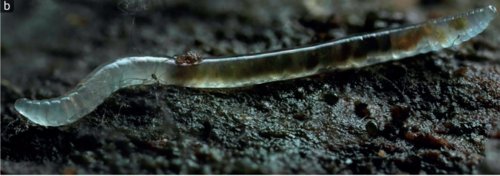
Enchytraeids, often referred to as potworms, are small, segmented worms that thrive in various habitats, including moist soil and aquatic environments. They’re often found in rich, organic material, where they munch on decomposing matter. When you consider the complexities of life in soil and water, these little worms contribute significantly to nutrient cycling and soil structure. So, let’s dive deeper into their fascinating world and explore why these worms are crucial to our ecosystems.
What Are Enchytraeid Worms?
Enchytraeid worms are part of the class Clitellata, closely related to earthworms. Though they are generally smaller, reaching lengths of only a few centimeters, they exhibit a fascinating range of colors and shapes. You might not think about these worms often, but they’re essential players in nature’s story.
These tiny creatures live in groups and are essential decomposers. They thrive in moist, organic-rich environments, like leaf litter or compost. As they feast on decaying material, they help break it down into simpler substances, making nutrients available to plants and fostering a healthy ecosystem. This process is crucial because it promotes soil fertility and overall ecosystem balance.
The Role of Enchytraeid in Soil Ecosystems
Honestly, when we talk about soil health, enchytraeids are right up there with earthworms and microbes. They help improve soil structure by creating tiny tunnels as they move through the earth. These tunnels allow air and water to permeate better, which is vital for plant roots to access.
Moreover, they consume organic matter, aiding in decomposition. This action not only recycles nutrients but also helps prevent that disgusting smell of rotting material. You see, when enchytraeids break down this organic matter, they speed up the composting process, turning waste into rich, fertile soil.
You might be wondering how they interact with other soil organisms. Well, enchytraeids often team up with bacteria and fungi, creating a vibrant soil community. This collaboration enhances nutrient cycling, making it easier for plants to absorb what they need. In other words, these worms are like the glue that holds the soil ecosystem together.
Enchytraeid and Aquatic Ecosystems
Now, let’s not forget their aquatic cousins! Enchytraeids are also found in freshwater systems, where they play a similar role. Think of them as the mini clean-up crew in ponds and streams. Their presence contributes to water quality by helping to decompose organic materials that might otherwise pollute water bodies.
In these aquatic environments, enchytraeids contribute to sediment health. They mix and aerate sediments, which can help maintain a balanced ecosystem. This is crucial because healthy sediments can support a diverse range of life, from fish to macroinvertebrates.
You might see them thriving in muddy bottoms of lakes, where they contribute to overall nutrient cycling. It’s all connected: as they break down decaying materials, they help keep the water clean and clear, benefiting all the organisms that call it home.
How Do Enchytraeid Worms Impact Biodiversity?
The impact of enchytraeid worms goes beyond just soil and water quality. They enhance biodiversity by providing food for various organisms. Birds, small mammals, and even some fish munch on these worms, making them an essential part of the food web.
When enchytraeids are abundant, they’re likely supporting a broader range of life. A healthy population of these worms indicates a robust ecosystem where different species thrive. So, the next time you see a bird snatching something from the ground, it could very well be a delicious enchytraeid worm!
Furthermore, their role in nutrient cycling supports plant health, ultimately contributing to the diversity of plant species. Healthy plants lead to a more resilient ecosystem capable of supporting diverse life forms, from insects to larger animals.
Environmental Indicators: What Enchytraeids Can Tell Us
Here’s the thing: enchytraeid populations can indicate the health of an ecosystem. Scientists often use them as bioindicators, meaning that changes in their populations can signal shifts in environmental conditions. If you notice a decline in these worms, it could hint at soil degradation or poor water quality.
Their sensitivity to pollutants and changing environmental factors makes them excellent indicators of ecosystem health. Noticing fewer enchytraeids might mean the ecosystem is under stress—whether due to pollution or habitat loss. This makes monitoring their populations a valuable tool for environmental scientists.
Maintaining healthy enchytraeid populations can enhance our understanding of ecosystem dynamics. It’s like they’re holding a mirror to the environment, reflecting its health and vitality.
Conservation and Future of Enchytraeid Worms
As habitats face increasing threats from pollution and climate change, it’s crucial to consider the future of these little worms. Protecting their environments is essential for maintaining biodiversity and ecosystem health. Conservation efforts focused on soil and water quality can have a direct positive effect on enchytraeid populations.
You might wonder how you can help. Simple actions like supporting organic gardening, reducing pesticide use, and advocating for clean waterways can play a role. By creating healthy habitats, we can ensure that enchytraeids continue to thrive and do their essential work.
In a nutshell, when we take care of our ecosystems, we’re not just protecting worms; we’re safeguarding the intricate web of life that sustains us all.
So, as we wrap up our exploration of enchytraeid worms and their roles in soil and aquatic ecosystems, it’s clear that these tiny creatures are far more significant than they appear. They support nutrient cycling, enhance soil structure, contribute to biodiversity, and even serve as indicators of environmental health.
In a world where pollution and environmental stress are on the rise, we need to pay attention to the little things—like enchytraeid worms. They remind us that every creature, no matter how small, has a vital part to play in the stories of our ecosystems. By understanding and protecting these worms, we contribute to a healthier planet for generations to come.
